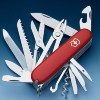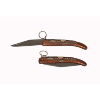Bernard Levine in his book "Guide to Knives, and this web page, The Congress Knife: Y'all Come Together!, claim that the Congress pattern knife was popular, or made for, the Southern region of the United States. This is hard to evaluate, based on a few old timers I have met, maybe it was up to the 1960's. With the mobility of today's America, it would be hard to prove that any one pattern predominates in any region. But I do believe the claim that the Congress was predominately a Southern knife.
Probably inspired the "Johnny Reb" edition of the Great American Story knives, this pattern came out in 1975.


This came from a flea market vendor. Based on the emblem, probably 1960's to 1970's, might be earlier, I don't have a good basis to establish a firm date.

This American made Boker is likely from the 1970's

The
Laguiole has a clear French lineage. It makes for an excellent kitchen knife.






It is very poor for pocket carry due to the fact the French, for what ever reason, produce this knife with very little clearance between the edge and the spring. A few makers don't control this, and I have a few of these where the knife came from the factory with the edge, or the tip, in contact with the spring! I really dislike self dulling knives! The examples I have from Vent d' Aubrac and En Aubrac don't have this problem, the factory made the spring with with a high point to elevate the blade off the spring. The best way to deal with a Laquoile that allows the edge to contact the mainspring is to glue a strip of cartridge brass on the mainspring under the ricasso of the blade. I had to adjust the brass thickness to keep the point inside the handle, as there is very little adjustment clearance in this design. Given there is little clearance inside the handle, with a closed blade, the edge will make contact with the mainspring if pocket carried. .
Due to an eccentric cam, the blade is stays open with a significant amount of spring pressure. You cannot let the blade snap closed under spring pressure as the edge will contact the spring. I have to hold the blade almost all the way down before releasing.
While the fit, polish, and Sandvick steels are excellent, I have no idea why the French make this knife with so little clearance between the edge and the mainspring. This is my major compliant as, too often, I have had to sharpen the edges due to pocket carry damage, or if the blade snaps closed.
The handle materials drive the cost. Mammoth ivory, Ram's horn, exotic woods, even semi precious gems, are made into handle slabs. The more exotic the material, the higher the price!

















